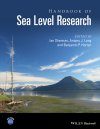About this book
Measuring sea-level change – be that rise or fall – is one of the most pressing scientific goals of our time and requires robust scientific approaches and techniques. This Handbook aims to provide a practical guide to readers interested in this challenge, from the initial design of research approaches through to the practical issues of data collection and interpretation from a diverse range of coastal environments. Building on thirty years of international research, the Handbook comprises 38 chapters that are authored by leading experts from around the world. The Handbook will be an important resource to scientists interested and involved in understanding sea-level changes across a broad range of disciplines, policy makers wanting to appreciate our current state of knowledge of sea-level change over different timescales, and many teachers at the university level, as well as advanced-level undergraduates and postgraduate research students, wanting to learn more about sea-level change.
Contents
List of contributors vii
Preface xi
About the companion website xiii
1. Introduction 1
Ian Shennan, Antony J. Long, and Benjamin P. Horton
2. Handbook of sea-level research: framing research questions 3
Ian Shennan
PART 1: Field techniques for sea-level reconstruction
3. Pre-fieldwork surveys 29
Robert C. Witter
4. Coastal sediments 47
Alan R. Nelson
5. Geomorphological indicators of past sea levels 66
Harvey M. Kelsey
6. Coastal caves and sinkholes 83
Peter J. van Hengstum, David A. Richards, Bogdan P. Onac, and Jeffrey A. Dorale
7. Coral reefs 104
Yusuke Yokoyama and Tezer M. Esat
8. Coral microatolls 125
Aron J. Meltzner and Colin D. Woodroffe
9. Archeological and biological relative sea-level indicators 146
Christophe Morhange and Nick Marriner
10. GPS and surveying 157
James Foster
11. Reference water level and tidal datum 171
Sarah A. Woodroffe and Natasha L. M. Barlow
PART 2: Laboratory techniques
12. Techniques and applications of plant macrofossil analysis in sea-level studies 183
Martyn Waller
13. Foraminifera 191
Robin Edwards and Alex Wright
14. Pollen and spores of terrestrial plants 218
Christopher E. Bernhardt and Debra A. Willard
15. Diatoms 233
Yongqiang Zong and Yuki Sawai
16. Ostracods and sea level 249
Thomas M. Cronin
17. Mollusca 258
Jessica E. Pilarczyk and Donald C. Barber
18. Fixed biological indicators 268
Alessio Rovere, Fabrizio Antonioli, and Carlo Nike Bianchi
19. Testate amoebae 281
Dan J. Charman
20. Stable carbon isotope and C/N geochemistry of coastal wetland sediments as a sea-level indicator 295
Nicole S. Khan, Christopher H. Vane, and Benjamin P. Horton
21. Loss on ignition and organic content 312
Andrew J. Plater, Jason R. Kirby, John F. Boyle, Timothy Shaw, and Hayley Mills
22. Grain size analysis 331
Adam D. Switzer and Jeremy Pile
PART 3: Dating methods
23. Radiocarbon dating and calibration 349
Torbjörn E. Törnqvist, Brad E. Rosenheim, Ping Hu, and Alvaro B. Fernandez
24. 210Lead and 137Cesium: establishing a chronology for the last century 361
D. Reide Corbett and J.P. Walsh
25. Chronohorizons: indirect and unique event dating methods for sea-level reconstructions 373
Wil Marshall
26. Uranium-thorium dating 386
Andrea Dutton
27. The application of luminescence dating in sea-level studies 404
Mark D. Bateman
PART 4: Modeling
28. Glacial isostatic adjustment 421
Glenn A. Milne
29. Tidal modeling 438
Stephen D. Griffiths and David F. Hill
30. Compaction 452
Matthew J. Brain
31. Transfer functions 470
Andrew C. Kemp and Richard J. Telford
32. Using chronological models in late Holocene sea-level reconstructions from saltmarsh sediments 500
Andrew C. Parnell and W. Roland Gehrels
33. Paleogeography 514
Geert-Jan Vis, Kim M. Cohen, Wim E. Westerhoff, Johan H. Ten Veen, Marc P. Hijma, Ad J.F. van der Spek, and Peter C. Vos
34. A protocol for a geological sea-level database 536
Marc P. Hijma, Simon E. Engelhart, Torbjörn E. Törnqvist, Benjamin P. Horton, Ping Hu, and David F. Hill
PART 5: Direct measurements
35. Sea-level measurements from tide gauges 557
Philip L. Woodworth, David T. Pugh, and Andrew J. Plater
Index 575
Customer Reviews
Biography
Professor Ian Shennan, also from the Department of Geography of Durham University, UK undertakes research on sea-level change, earthquakes and tsunami and the development of relevant scientific approaches and techniques.
Professor Antony J Long, from the Department of Geography of Durham University, UK is a sea-level scientist with a particular interest in reconstructing past sea-level change from polar regions.
Dr Ben Horton is a Professor at the Institute of Marine and Coastal Science of Rutgers University, New Jersey, USA. He aims to understand and integrate the external and internal mechanisms that have determined sea-level changes in the past, and which will shape such changes in the future. All three have conducted field-based research in diverse environments, from the tropics to high latitudes, much with the backing of the major research agencies in the UK, Europe and the USA as well as commercial and government stakeholders.






































